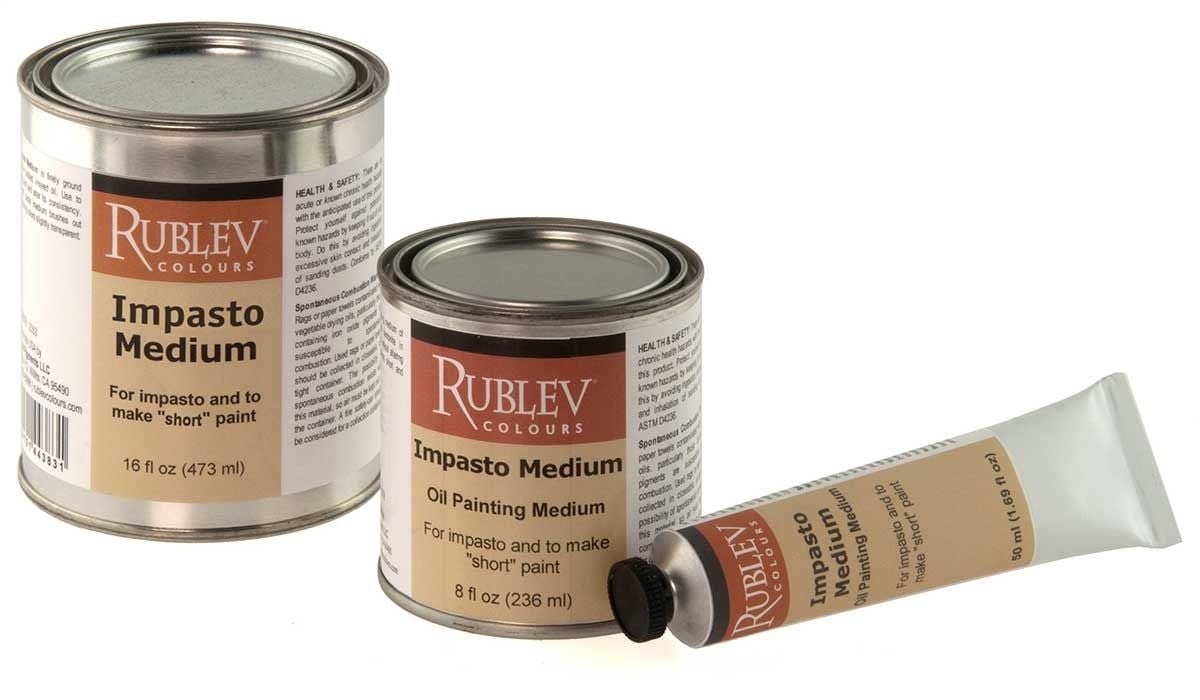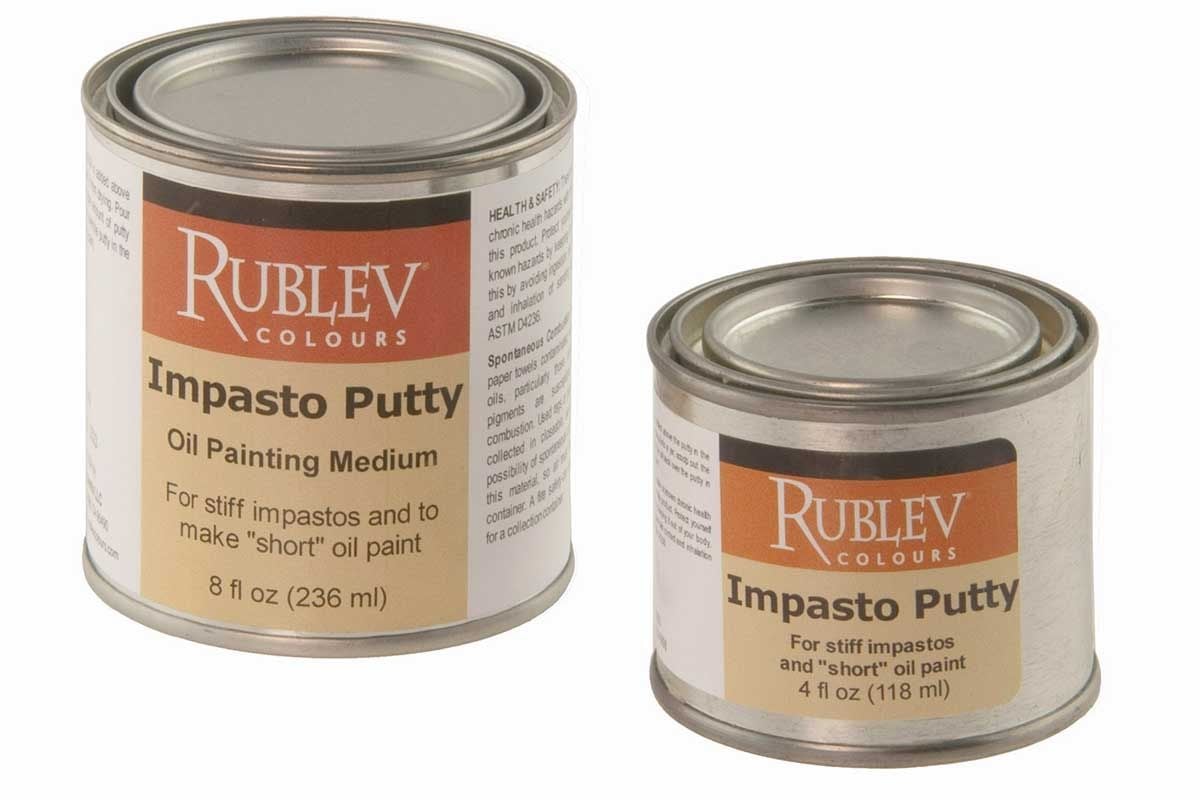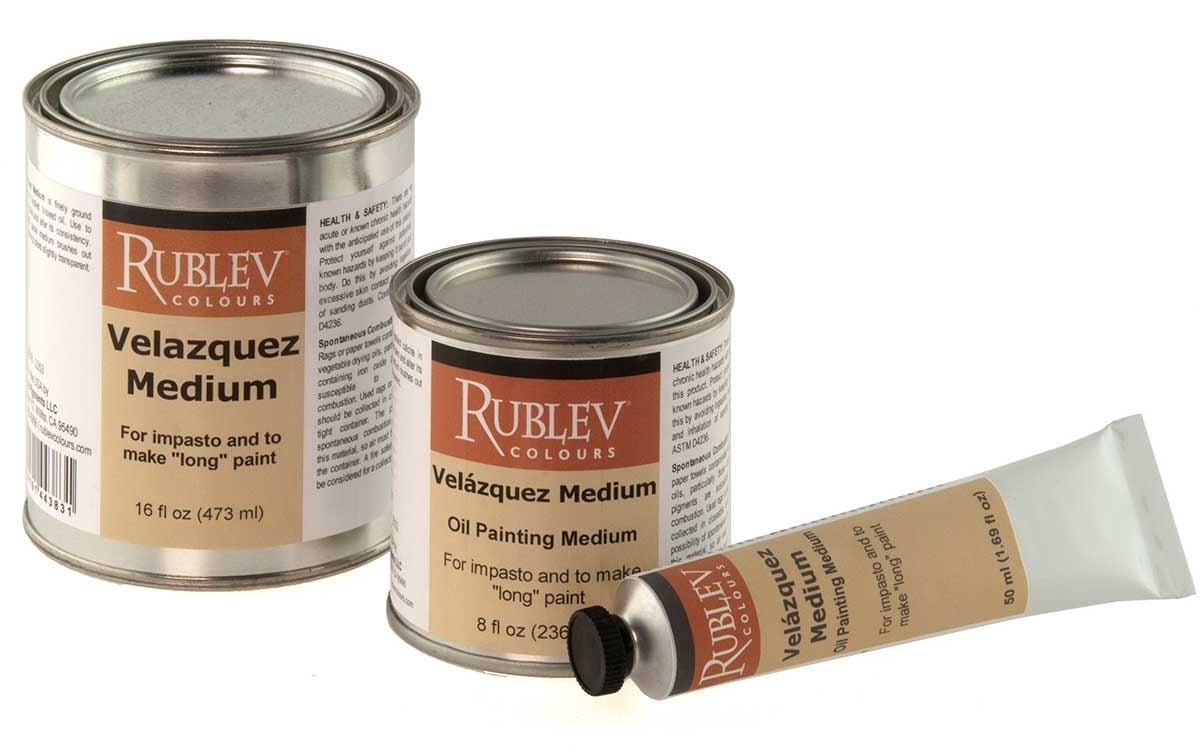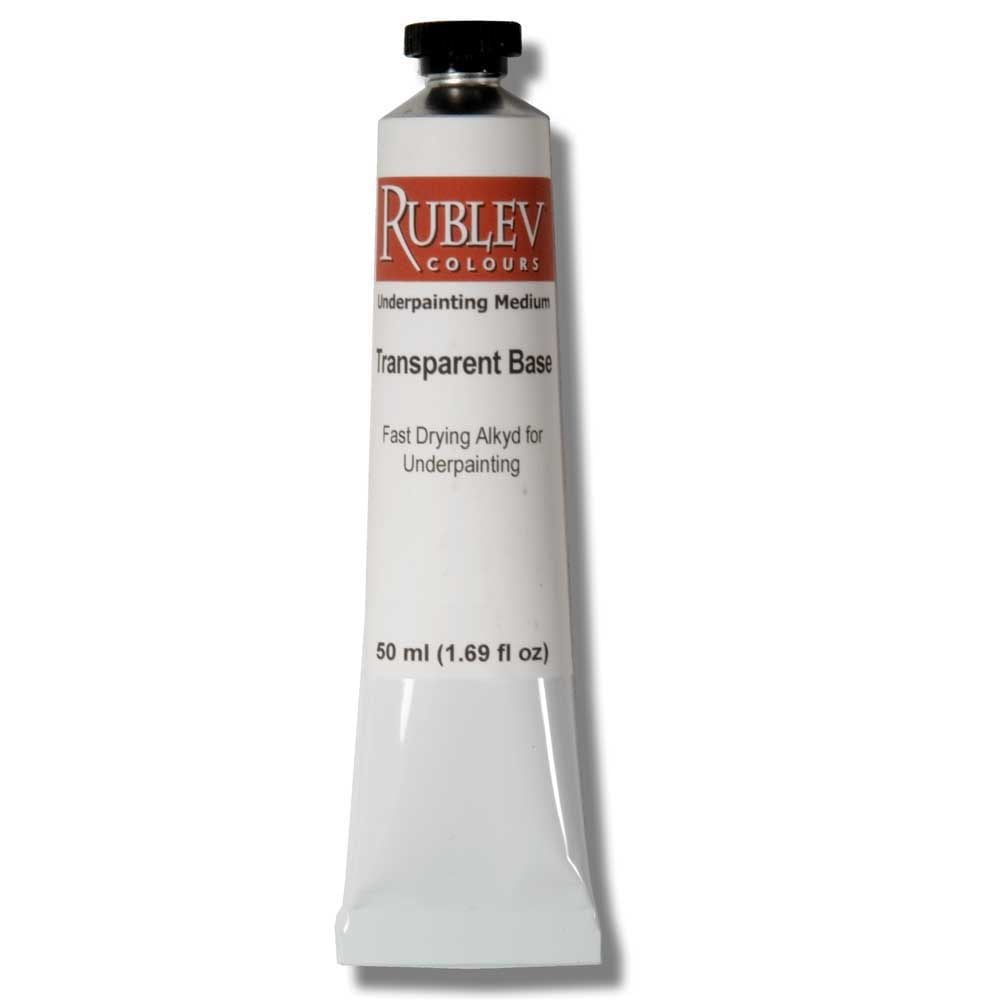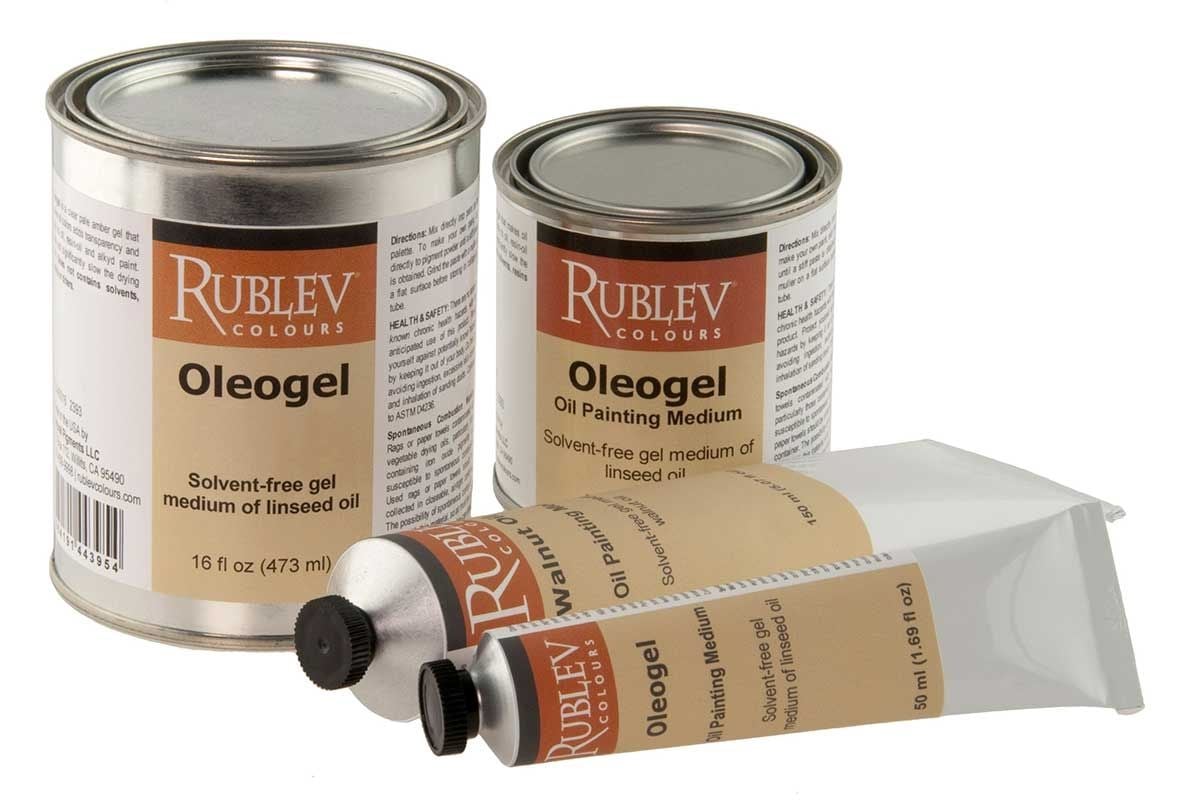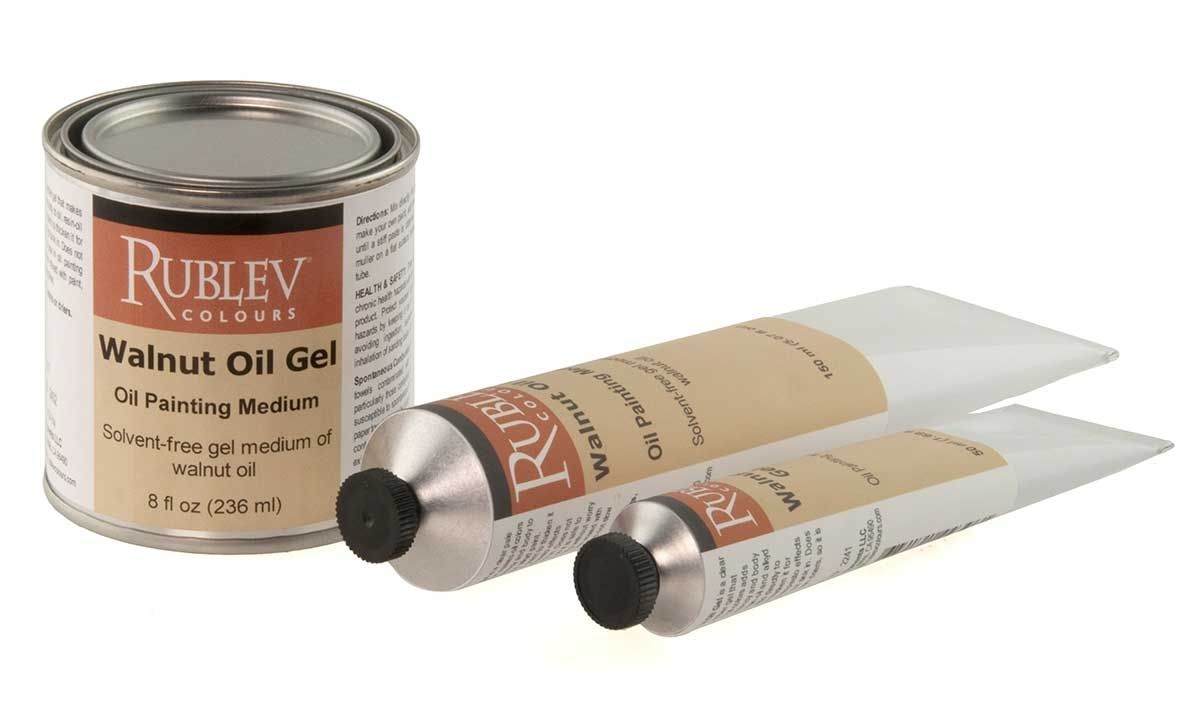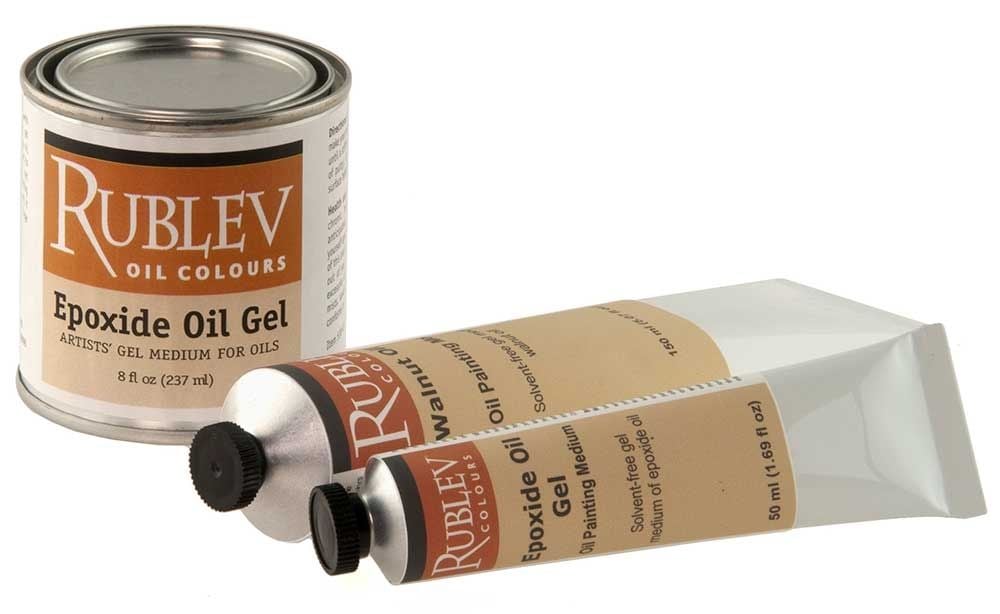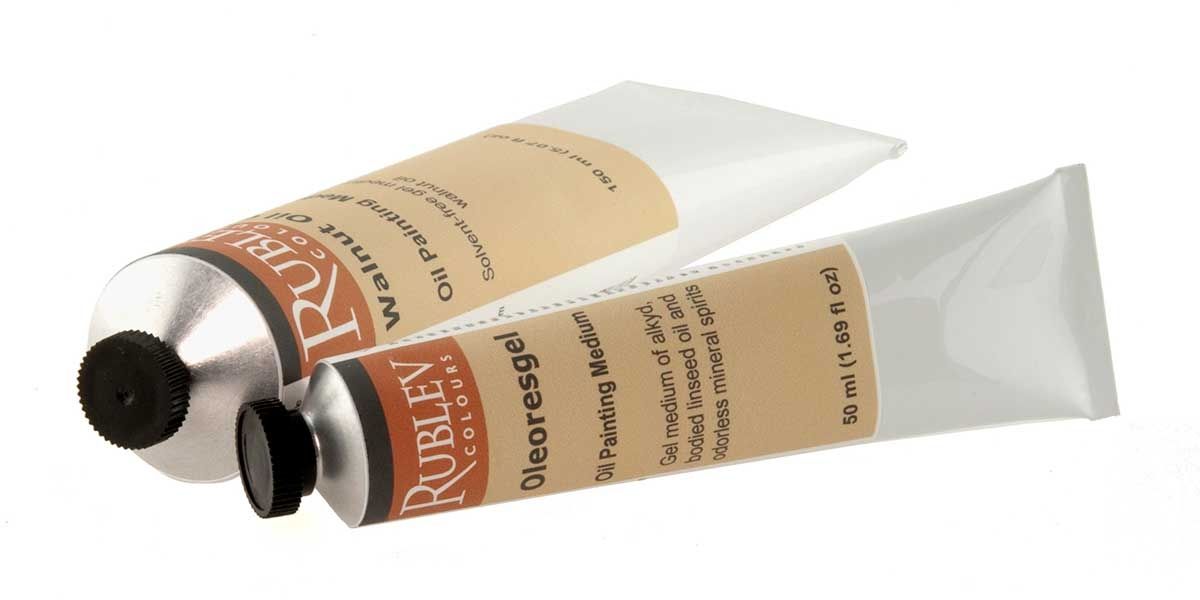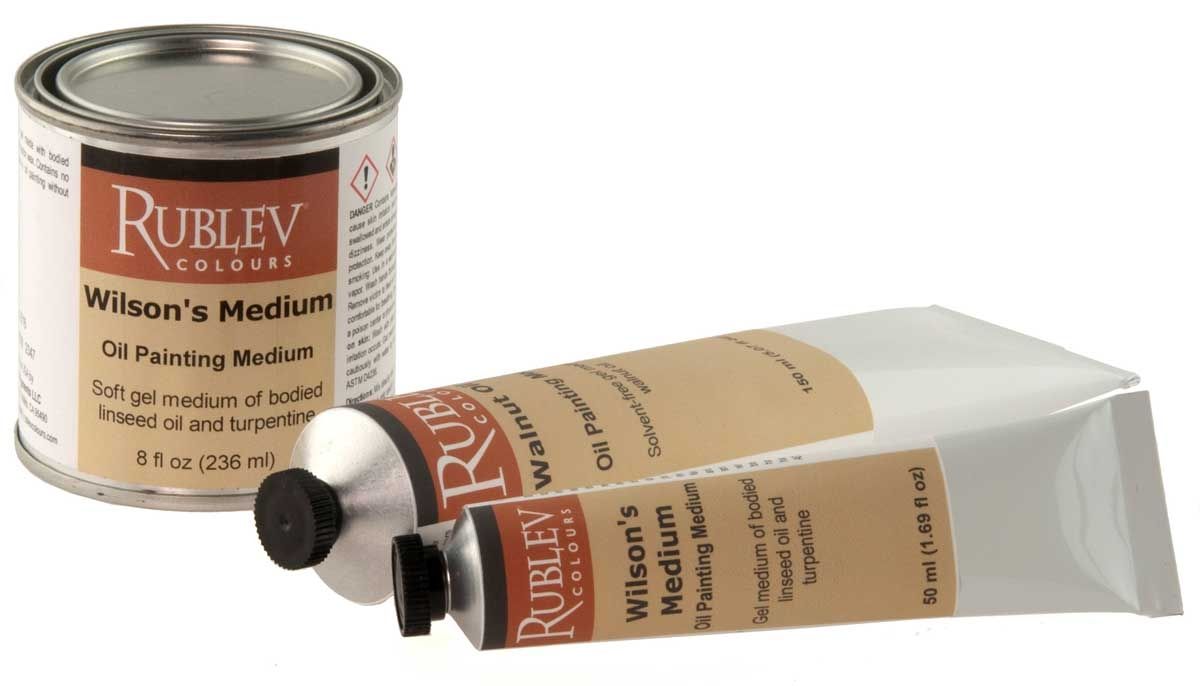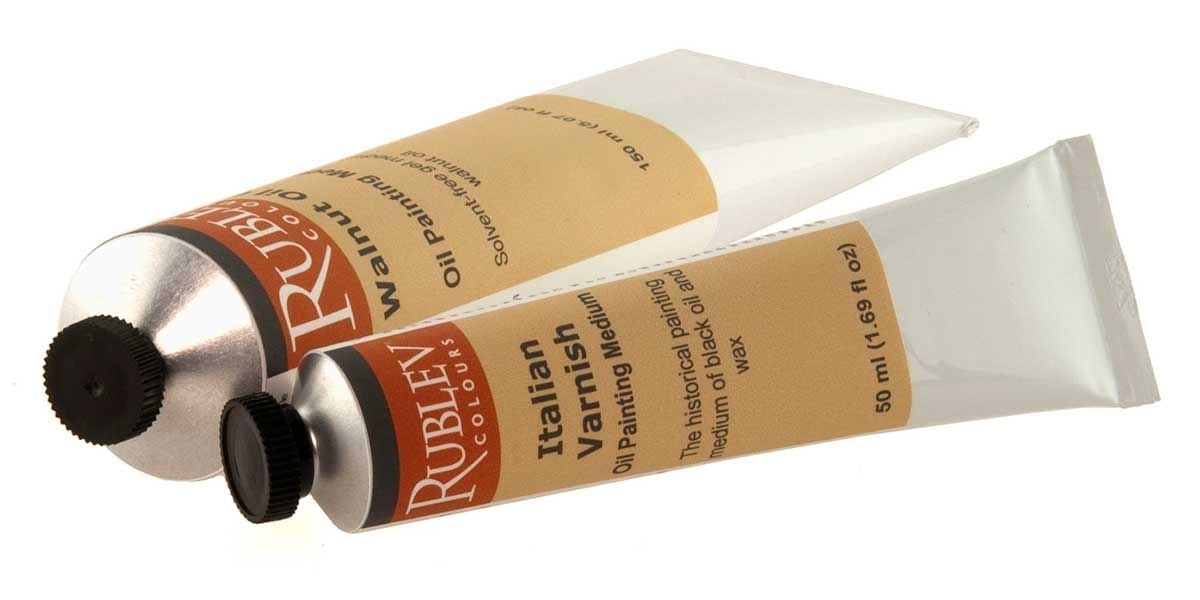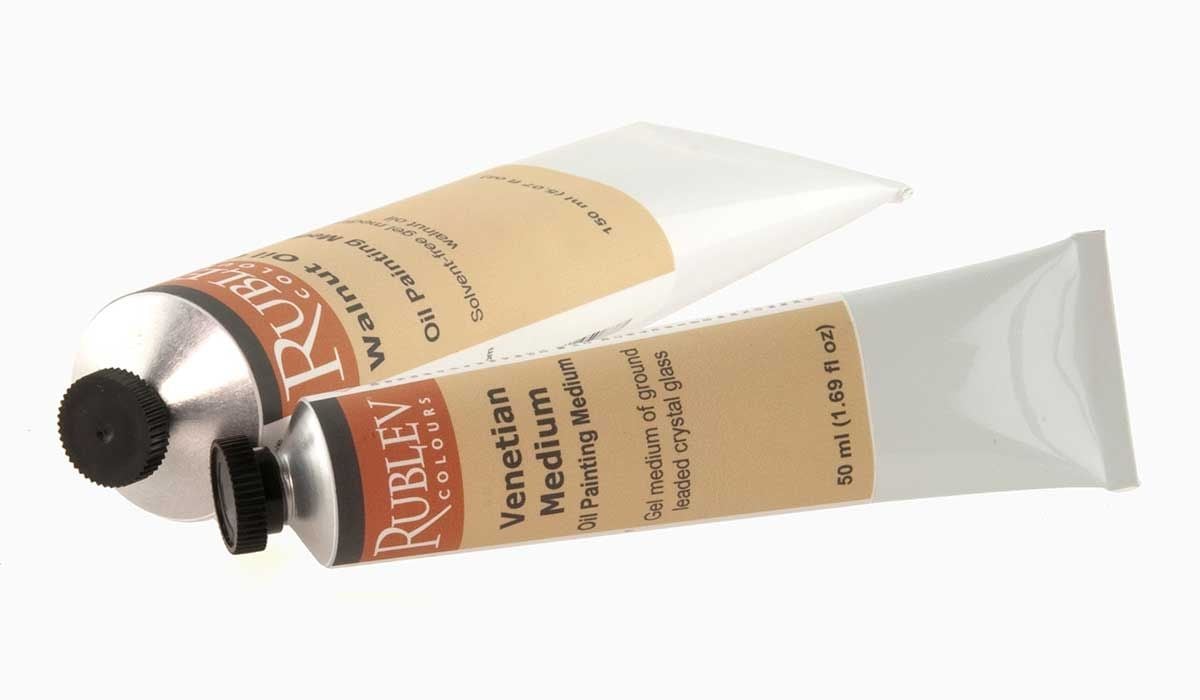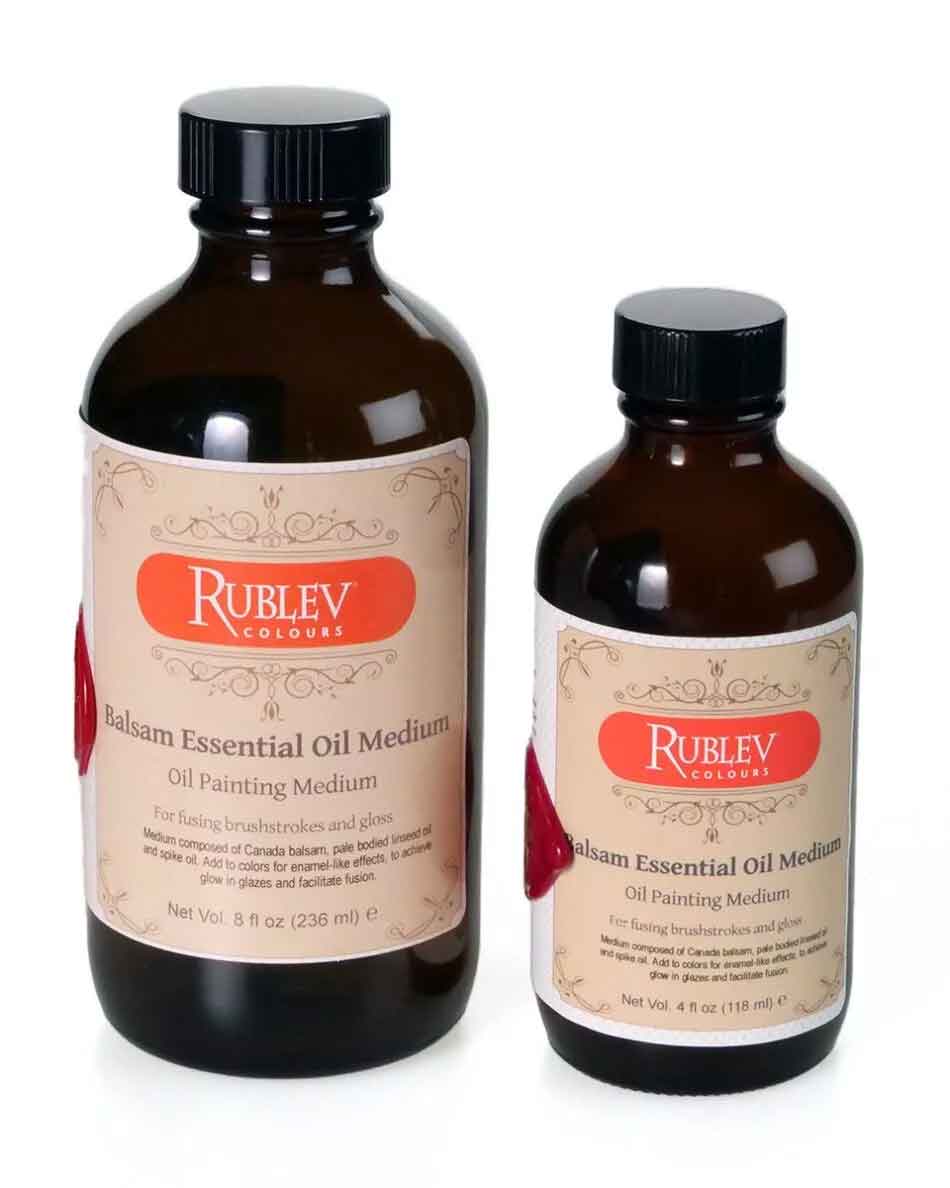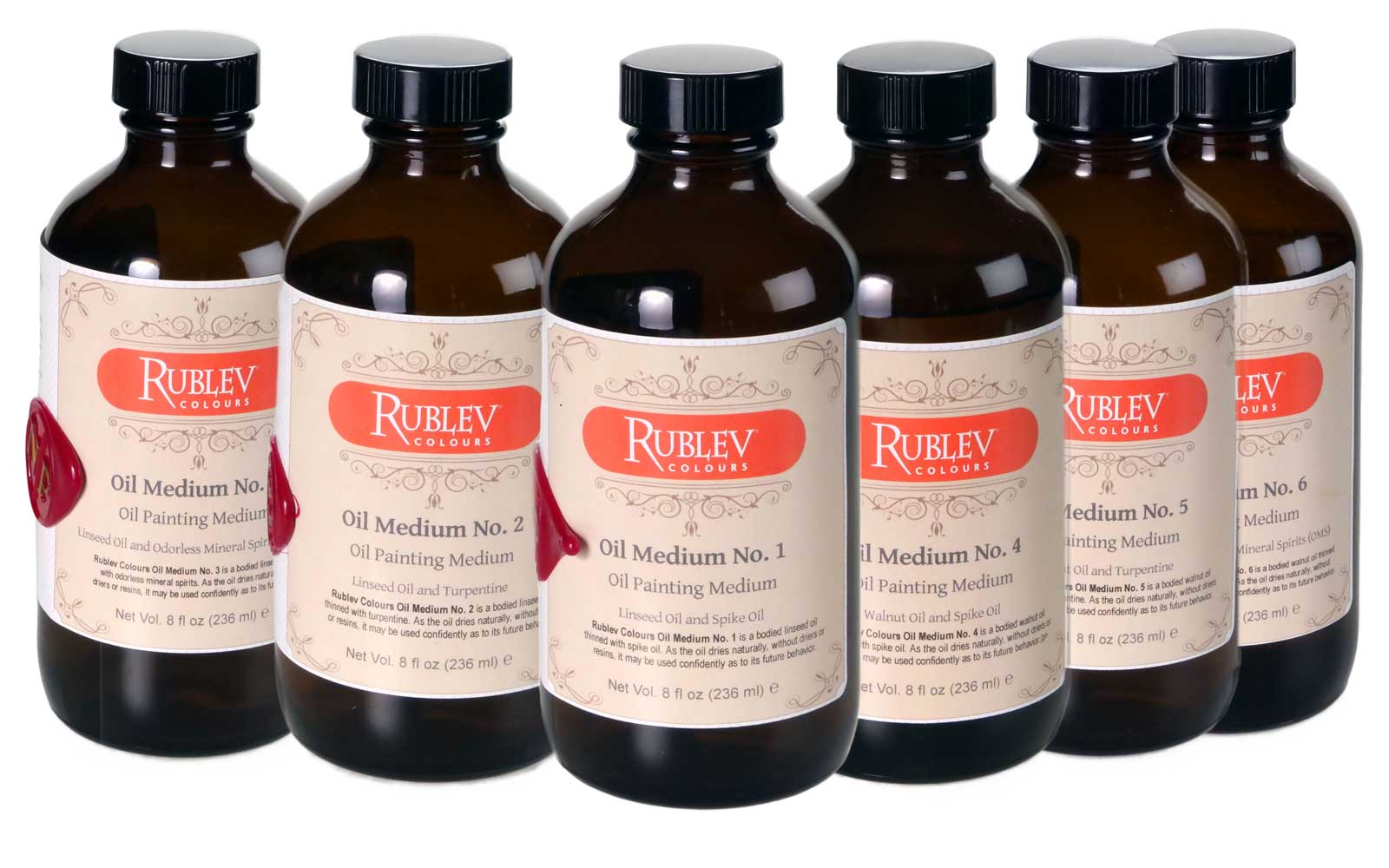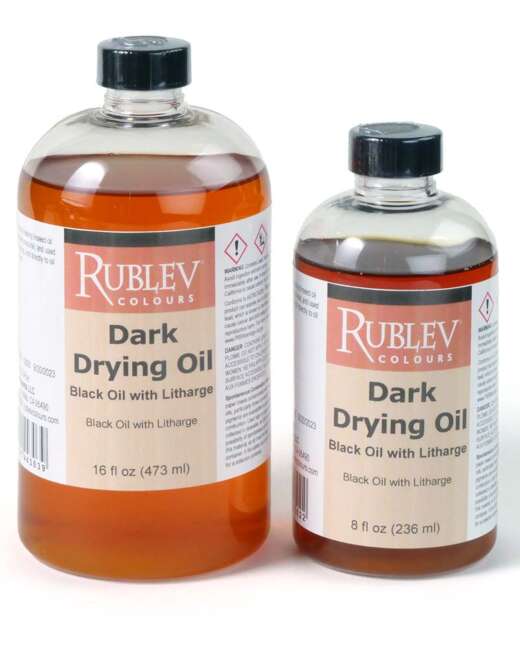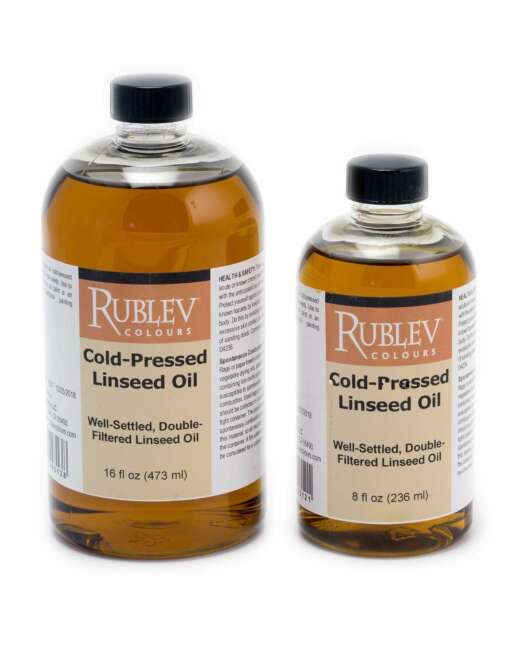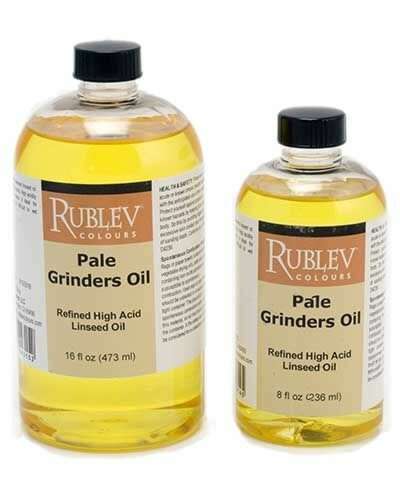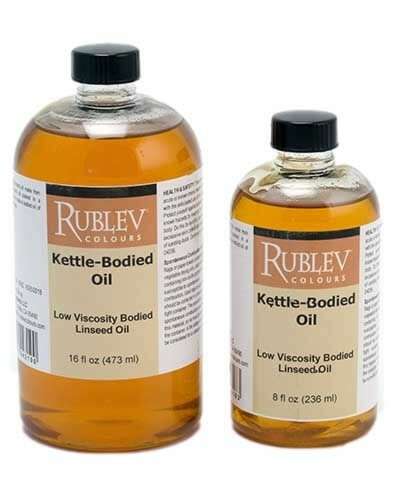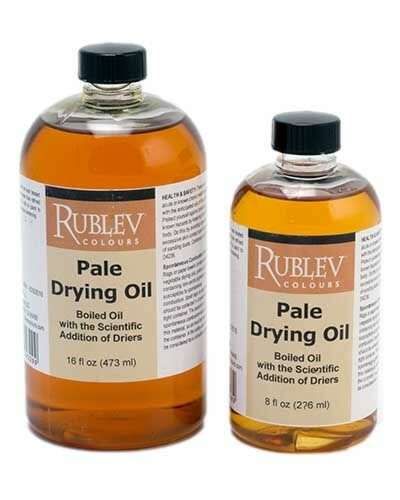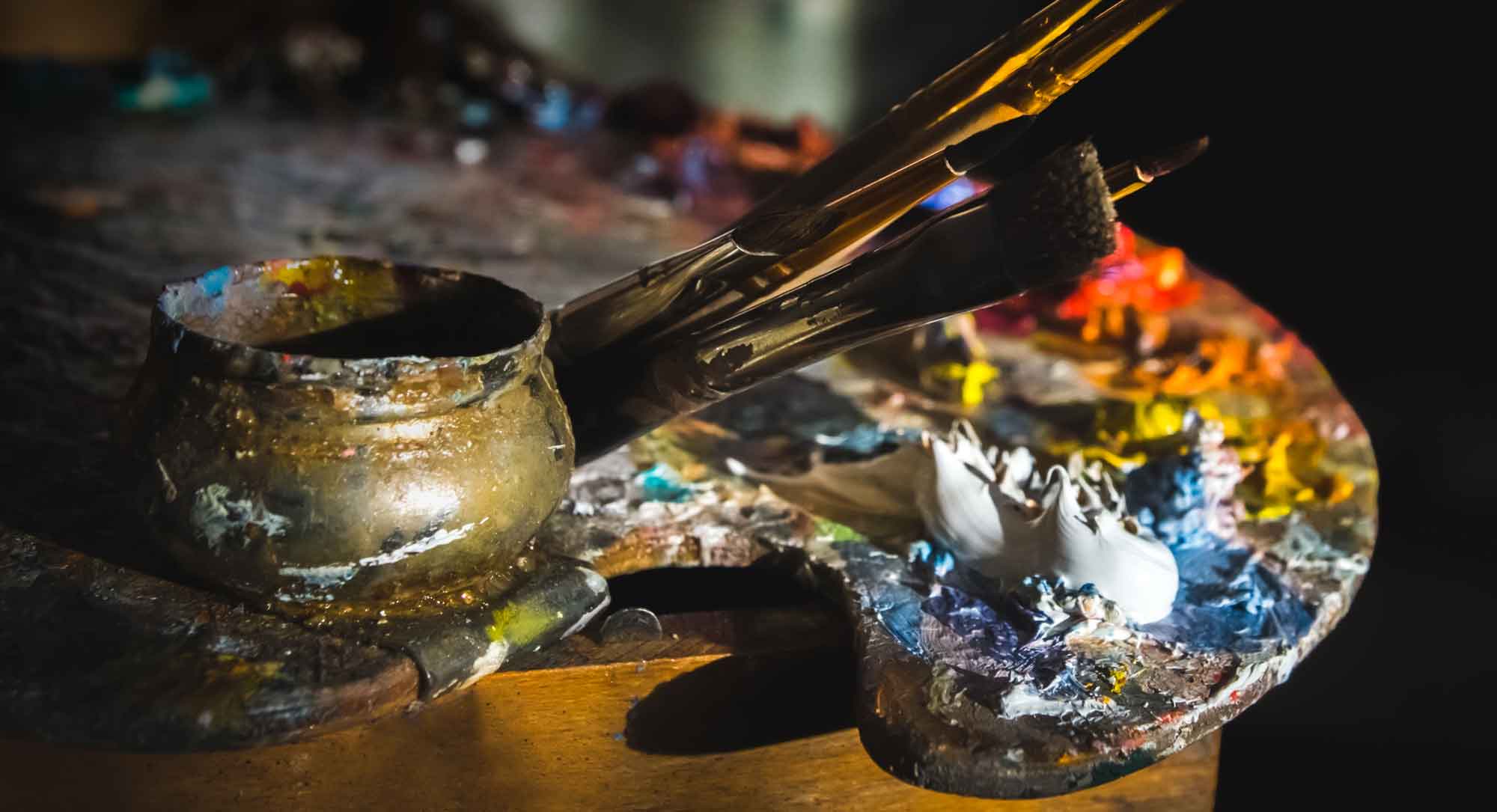
In painting, “medium” refers to both the type of paint and an amendment to alter the properties of paint. A painter can prepare a medium with solvents, resins, wax, and other substances to control the consistency of oil paint. The term “paint medium” often refers to the fluid that carries pigments, but this is more appropriately called a “vehicle,” which is typically composed of a solid binder and a solvent or diluent. An example of an artist painting vehicle is watercolor, where gum arabic is the binder and water is the diluent or vehicle.
Oil paint is a slow-drying paint consisting of pigment particles suspended in a drying oil, commonly linseed oil. The viscosity of the paint may be modified by adding a solvent, such as turpentine or mineral spirits (white spirits), and varnish may be added to increase the glossiness of the dried film. Extender pigments are added to increase bulk and thicken the medium.
Mediums are a mixture of several basic ingredients. They can combine some or all of these—a drying oil, a solvent, a resin, an extender pigment, and a drier. Understanding how each ingredient behaves helps you to choose the right medium for your painting and to produce structurally sound artwork that will last.
In this article, you will learn how oil painting mediums behave to modify the viscosity, rheology, surface finish, and drying time of oil paint. We then give an overview of the main components of oil painting mediums. We explain how these amendments alter the consistency of oil paint in novel ways.
Painting mediums change the handling properties of paint, such as flow out and leveling; increase or decrease tackiness and drag; hasten or retard drying time, increase or decrease gloss, increase transparency, or other characteristics.
| Amendment | Glazing | Impasto | Oiling Out | Drying Time* |
| Paste Mediums | ||||
| Impasto Medium | Yes | Best | No | 2 |
| Impasto Putty | Yes | Best | No | 2 |
| Velázquez Medium | Yes | Best | No | 2 |
| Underpainting Transparent Base1 | No | Yes | No | 5 |
| Gel Mediums | ||||
| Oleogel | Best | Yes | Best | 2 |
| Walnut Oil Gel | Best | Yes | Best | 1 |
| Epoxide Oil Gel | Best | Yes | Best | 3 |
| Oleoresgel | Best | Yes | Best | 3 |
| Wilson’s Medium | Best | Yes | Best | 4 |
| Italian Varnish | Best | Yes | Yes | 3 |
| Venetian Medium | Best | Yes | Yes | 4 |
| Fluid Mediums | ||||
| Balsam Essential Oil Medium | Best | No | No | 3 |
| Rublev Colours Oil Mediums | Best | No | Yes | 2–4 |
*Drying Time: 1 for slowest and 5 for fastest. Drying time is the amount of time it takes for oil paint to be dry to the touch after application. The paint, however, remains vulnerable to damage from wiping or brushing. As oil paint dries, its solid components adhere to each other, a process called ‘curing.’ When fully cured, you can apply another layer of paint without fear of harm, wrinkling, or cracking. For example, oil paint may dry within 6–8 hours but cure in 3–7 days.
Notes:
1 Underpainting Transparent Base dries very quickly to a matte surface, making it ideally suited for underpainting.
Paste Mediums
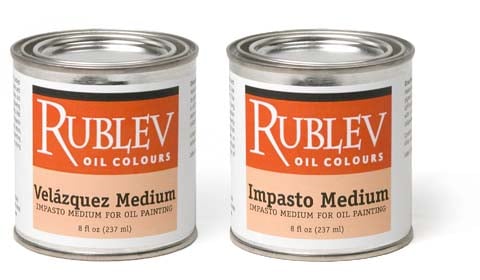
Studies of Diego Velázquez’s paintings have found ground calcite (calcium carbonate) not only in the grounds (typical of seventeenth-century support preparation) but also in the paint layers. It is possible he used a paste medium composed of bodied oil and ground calcite (calcium carbonate) added to colors, such as in the imprimatura of The Education of the Virgin. [1] That calcite was often added to oil paint by other seventeenth-century painters is described in recent studies, such as in the book Rembrandt: Art in the Making. It became clear that Rembrandt used a combination of bodied linseed oil and calcite in his paintings.
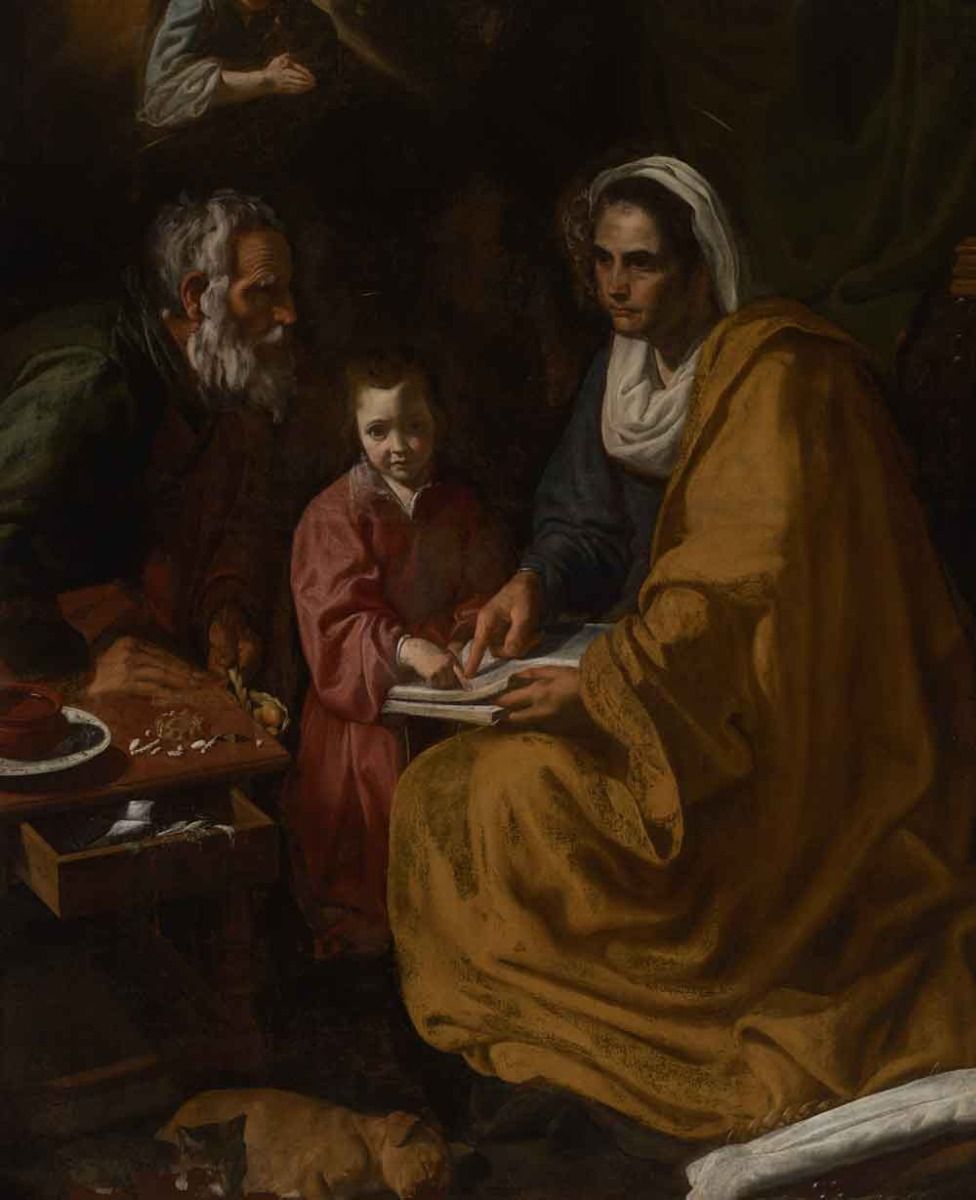
Diego Velázquez (1599–1660), The Education of the Virgin ca. 1617–18, Oil on canvas, 168 × 136 cm (66 1/8 × 53 9/16 in.), Yale University Art Gallery
Pastes of calcite and oil can be used to achieve a variety of effects and are especially useful in making impastos. When used in conjunction with oil colors, they broaden the functional properties and expand the creative possibilities of oil paint. Unlike gels, pastes are opaque because they contain calcite or other fillers (also called ‘extender pigments’) that are initially off-white but, when mixed with colors, do not tint them.
Solvent-free painting in a variety of styles can be done using paste mediums. Paste mediums can be simple or complex in terms of their ingredients. The simplest paste medium consists of calcite and oil mixed to a consistency that works for the painter’s style.
Calcite is a naturally occurring calcium carbonate (CaCO3) mineral in rocks such as chalk, limestone, and marble. These rocks are the primary sources of pigment. Its whiteness, softness, and fine-grained nature make it an ideal white pigment, both abundant and easily processed. Chalk is relatively transparent in most paint media and is often used as an extender of other pigments and employed with animal glue as a ground for painting.
History of Calcite in Art
Calcium carbonate, in various forms, has a long history in art. It has been recognized, for example, in Greek and Roman art. Its use in art since that time has been both persistent and widespread. In northern Europe, from medieval times, chalk was employed with animal glue for making the ground or preparation layer of paintings. Sometime later, lead white was mixed with the chalk to make it denser and whiter. Chalk was used with animal glue or other aqueous binders as a white pigment.
Calcite has been used in oil painting, being added to colors, especially lead white, by such artists as Velázquez and Rembrandt. The transparency of chalk was desirable in some Dutch tonal landscapes of the seventeenth century.
Uses of Calcite in Paint
Calcium carbonate is commonly used in combination with other pigments in oil paint because of its low refractive index and poor hiding power. However, linseed oil and chalk have long been used together to prepare putty. The transparency of chalk in oil makes it ideal for adding bulk to oil colors or affecting the consistency (rheology) of paint.
Calcium carbonate is often used as an extender pigment to reduce the cost of the paint. Its alternative names, such as chalk and whiting, are used in many formulations. An important use of calcium carbonate is in mixtures with titanium dioxide pigment to act as a spacer, keeping the titanium white particles spread apart and ensuring better efficiency in scattering light and increasing opacity. Calcium carbonate is often used to vary the gloss of powder coating materials, depending on the particle size used.
Variations of Calcite and their Effects on Paint
Calcium carbonate derived from different mineral sources behave differently in paint. The material can be ground from limestone, a sedimentary rock formed in sea beads or alluvial deposits; or marble, which is limestone that has undergone heat and pressure below the earth’s crust; or chalk, a light, low structure material generally associated with the sedimentary deposition of the shells of such minute marine organisms as foraminifera, coccoliths, and rhabdoliths. The particle structure and chemical behavior of these variations of calcite all differ slightly.
The particle size and shape of calcite regarding the behavior and performance of paint are essential for several reasons. One is the viscosity of the paint, which is related to the volume occupied by the dispersed solids within the paint vehicle. In the case of particles that are not spherical, the “spherical equivalent” volume may be the maximum volume inscribed by the rotation of a particle. Because of this, a non-spherical particle may behave as if it occupies much more volume than it does.
Another consideration of particle size and shape’s influence on the paint’s behavior is the particle’s surface area. The amount of paint binder required by a pigment to form a paste paint is called its oil absorption number. The greater the surface area of the particle, the more binder it demands to make into a paste or flowing paint. Synthetic (precipitated) calcium carbonate that consists of 0.05-micron needle-shaped particles has more surface area than the particles of ground limestone of the same size, which have simple structures resembling rhomboidal crystals. Because of the complex surface of the precipitated calcium carbonate, it will tend to scatter more light and appear more opaque than the ground limestone particles. However, precipitated calcium carbonate consumes considerably more binder than ground limestone.
When making paint or oil painting mediums, selecting the correct type of calcite considers the particle size and shape, brightness, chemical constituents, and surface treatment.
Impasto Medium is a calcite-rich oil painting paste medium
Rublev Colours® Impasto Medium
Shop Now for
Impasto Medium is an oil painting medium of finely ground calcite, barite, and bentonite in bodied linseed oil. Use it to extend paint without altering the consistency, making oil colors’ short’ and buttery for impastos. Stiffer than Velázquez Medium, this putty-like medium makes colors slightly transparent while allowing you to build impasted, thick paint applications. Impasto Medium does not alter its color temperature when added to oil paint. It can be thinned with solvent or oil. Depending upon the proportion added to the paint, Impasto Medium does not affect the drying time significantly.
Impasto Medium does not contain stearates, solvents, driers, or natural or synthetic resins, so it is safe to add to oil paint without the worry of cracking or delaminating.
Impasto Medium slightly increases the transparency of colors while maintaining the buttery consistency. It allows you to build impasto or thick paint with ease. When added to oil paint, brushstrokes hold their form without slumping or leveling. In the picture below, when added to green earth artist oil (bottom center), the mixture of Impasto Medium (bottom left) extends the color and consistency. In contrast, the mixture with Velázquez Medium (bottom right) gives the paint a long, ropy consistency.
Impasto Medium is available in 50 ml collapsible tubes, eight fluid-ounce (236.6 ml), and 16 fluid-ounce (473 ml) cans.
Impasto Putty is a calcite-rich oil painting paste medium of a very stiff, putty-like consistency.
Rublev Colours® Impasto Putty
Shop Now for
Impasto Putty is an oil painting medium of finely ground calcite, barite, and bentonite in bodied linseed oil. Use it to extend paint without altering the consistency, making oil colors’ short’ and buttery for impastos. Stiffer than Impasto Medium and Velázquez Medium, this putty makes colors slightly transparent while allowing you to build impasted, thick paint applications. When added to oil paint, Impasto Putty does not alter the color temperature of the paint. It can be thinned with solvent or oil. Impasto Putty does not affect the drying time depending on the proportion added to the paint.
The stiff white paste has little effect on oil colors, making them less opaque and slightly less saturated. Use it to build thick applications of color.
How to Use
Mix Impasto Putty directly into your paint right on the palette.
Impasto Putty is a great way to add calcite to your paint. Add Impasto Putty and linseed oil directly to dry pigment powder until a stiff paste is obtained (almost the consistency of putty). Grind the paste with a muller on a flat surface before storing it in a collapsible tube.
Impasto Putty is available in 4 fluid-ounce (118 ml) and eight fluid-ounce (236.6 ml) cans.
Velázquez Medium is a pure calcite oil painting paste medium
Rublev Colours® Velázquez Medium
Shop Now for
Velázquez Medium is an oil painting medium of finely ground calcite in bodied linseed oil. Use it to extend paint and alter its consistency, making oil colors’ long ‘* for finer detail and impastos. Softer than Impasto Medium, this flowing paste makes colors slightly transparent while allowing you to build impasted, thick paint applications. When added to oil paint, it does not alter the color temperature. It can be thinned with solvent or oil. Depending upon the proportion added to the paint, it does not affect the drying time significantly.
Velázquez Medium does not contain stearates, solvents, driers, or natural or synthetic resins, so it is safe to add to oil paint without the worry of cracking or delaminating.
*Long refers to the consistency of paint that displays tall peaks when a palette knife is pressed to its surface and lifted. Long paint is also described as “ropy” and refers to a stringy quality, like honey. Paint that behaves in this way is said to have long rheology. Short rheology refers to paint that exhibits a more buttery consistency, typical of most commercial oil paint. Rheology is the science of how substances flow, such as liquids and soft solids, that flow rather than deform elastically.
The soft white paste has little effect on color, making them less opaque and slightly less saturated. Use it to build thick applications of paint.
Velázquez Medium slightly increases the transparency of colors while introducing flow out and leveling. These properties allow you to create fine detail in impasto or thick paint easily. Although the paint becomes long when Velázquez Medium is added, it holds brushstrokes well. In the picture below, when added to green earth artist oil (bottom center), the mixture of Impasto Medium (bottom left) extends the color and consistency. In contrast, the mixture with Velázquez Medium (bottom right) gives the paint a long, ropy consistency.
Velázquez Medium is available in 50 ml collapsible tubes, eight fluid ounces (236.6 ml), and 16 fluid ounces (473 ml) cans.
Differences Between Paste Mediums
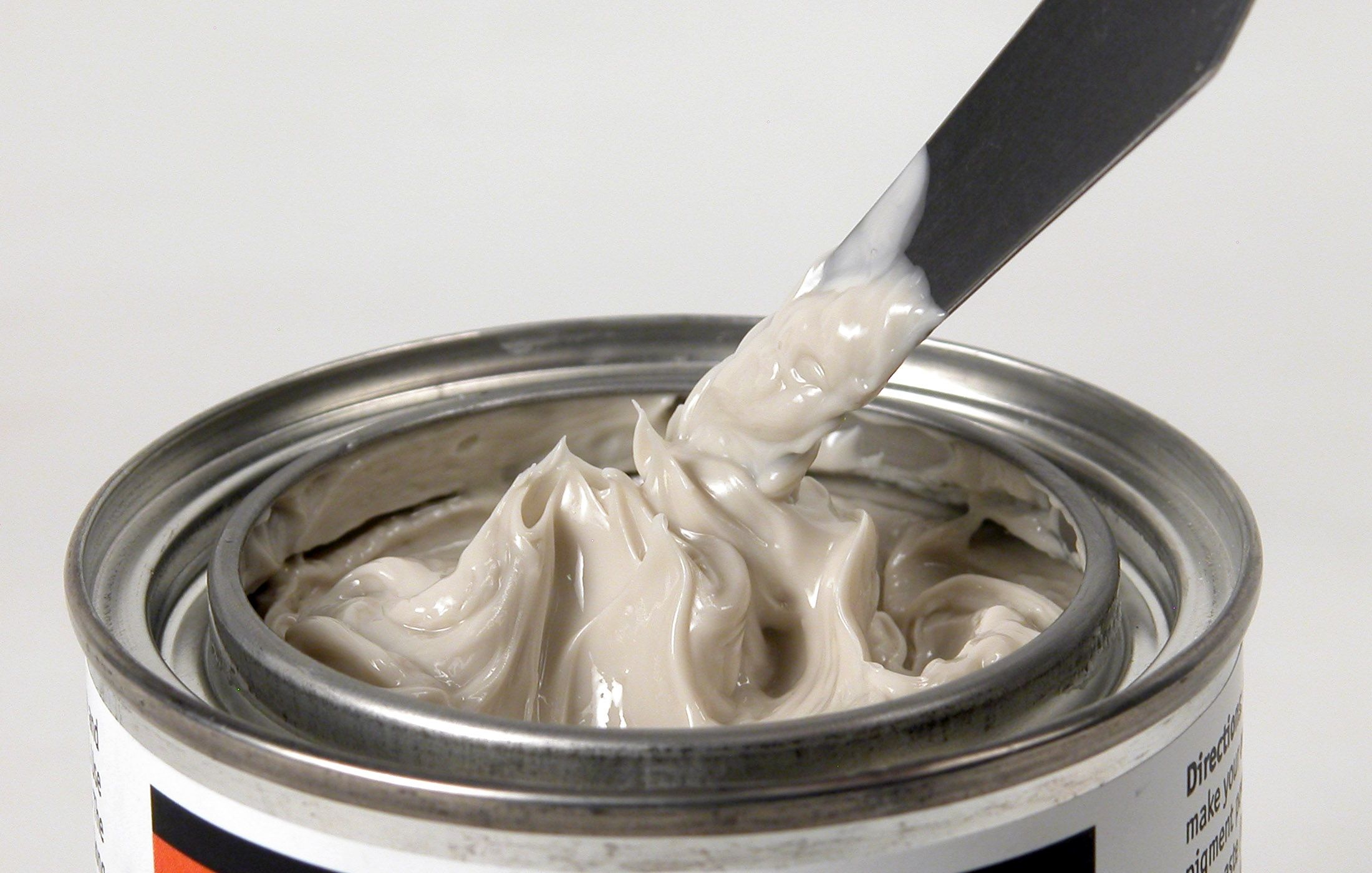
Impasto Medium imparts buttery (short paint) characteristics to oil paint.
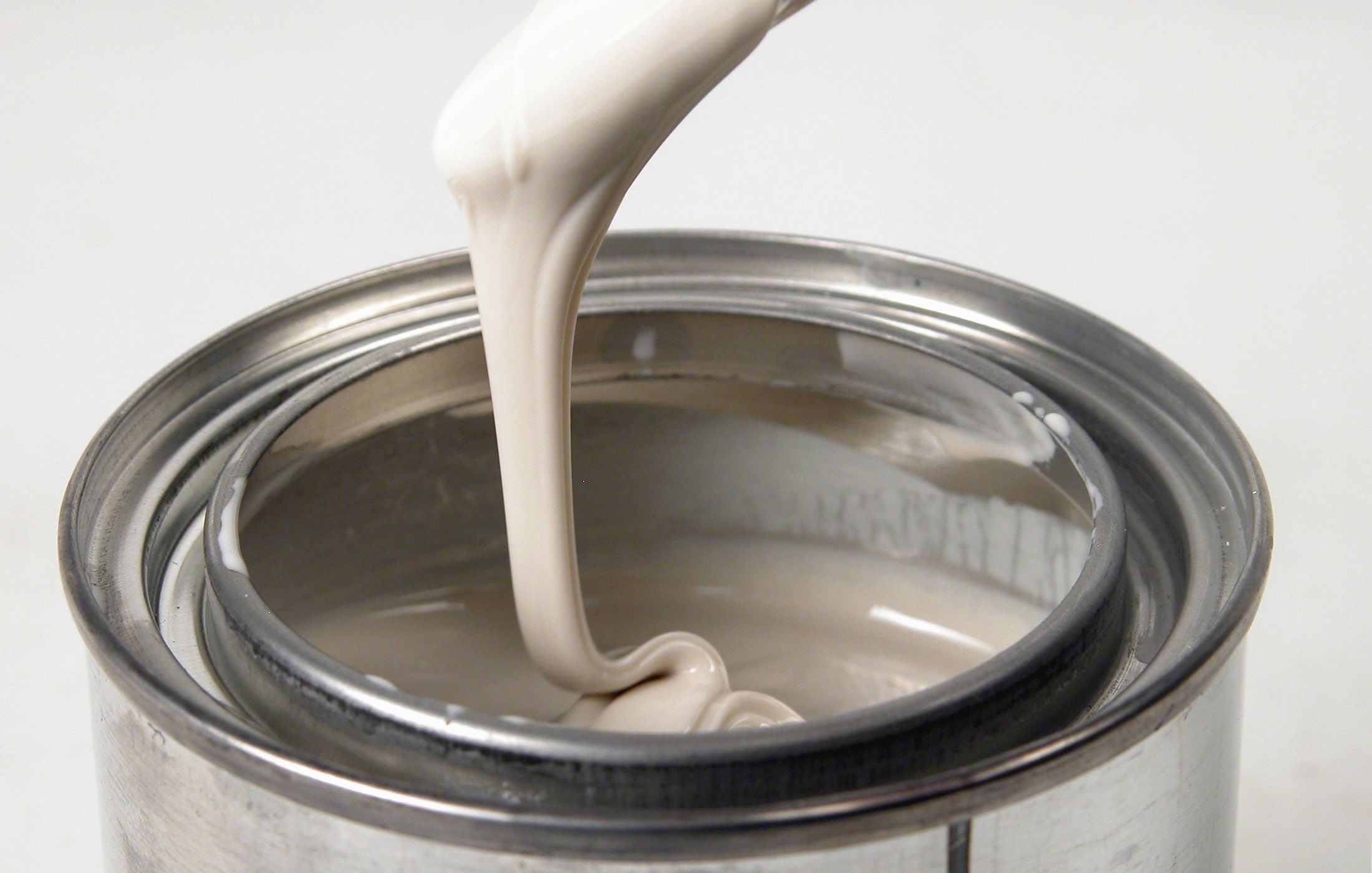
Velázquez Medium imparts flowing (long paint) characteristics to paint.
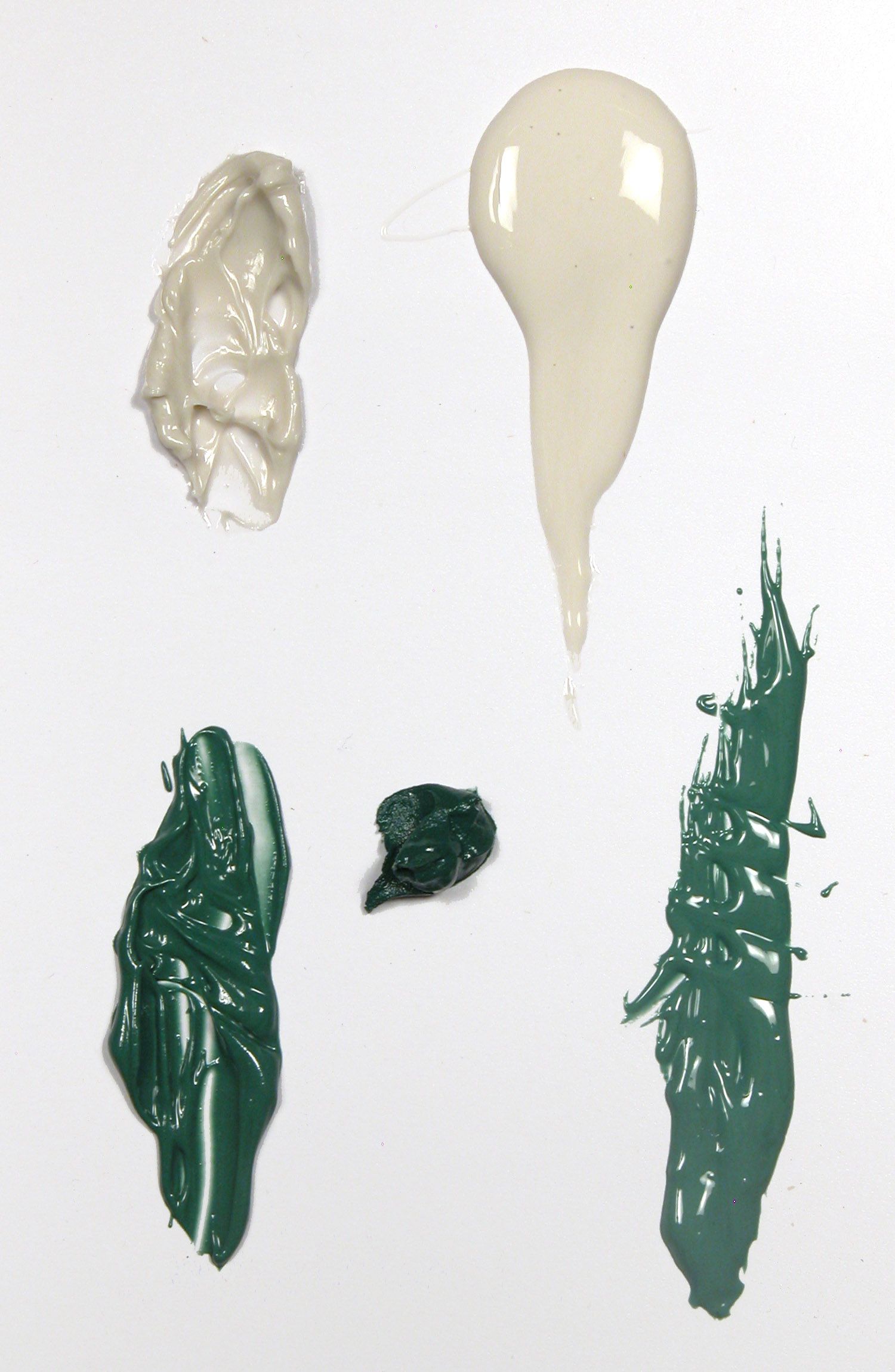
A comparison of Impasto Medium (top left) and Velázquez Medium (top right) shows the different handling characteristics when added to paint (bottom).
How to Use
Mix Rublev Colours paste mediums directly into your paint on the palette with a knife.
Rublev Colourspaste mediums are a great way to add calcite to your paint. Add the medium with linseed oil directly to pigment powder until a stiff paste is obtained (almost the consistency of putty). Grind the paste with a muller on a flat surface before storing it in a collapsible tube. Some of its properties will be temporarily lost when grinding the medium with a muller but should be restored when allowed to stand.
Underpainting Transparent Base is a calcite-rich alkyd paste medium
Rublev Colours® Underpainting Transparent Base
Shop Now for
Underpainting Transparent Base is a fast-drying, alkyd paste medium, similar to Velázquez Medium in handling properties, but much faster drying. This alkyd paste medium consists of finely ground calcite (ground calcium carbonate) and wollastonite in alkyd with mineral spirits. Use it to extend paint and form impastos while making paint longer. It makes colors slightly transparent, allowing greater control over tints without using whites. Dries to a matte finish. Does not contain driers.
Suggested Uses
Use Underpainting Transparent Base in the underlayers of a painting or as a medium in alla prima (direct) painting.
Not all painters use underpainting; it seems that those who do want it to dry fast so they can begin coloring in the overpainting. Natural Pigments has a simple solution that does not require buying a whole new set of colors just for the underpainting—introducing two products: Underpainting Lead White and Underpainting Transparent Base. With either or both products, you can use any of your standard oil colors and have them dry blindly fast—usually within an hour or so. Add the Underpainting Lead White or Transparent Base—from one-third to one-half—to your oil color, and your underpainting dries quickly to a matte sheen. Add less for slower drying.
How to Use
Add Underpainting Transparent Base directly to paint, mixing well on the palette. Do not apply Underpainting Transparent Base over slower drying oil paint, as this may lead to cracking or wrinkling of the layer. You can thin Underpainting Transparent Base with mineral spirits and linseed oil.
Underpainting Transparent Base is available in 50 ml and 150 ml collapsible tubes.
See Also. Underpainting Lead White (also known as flake white or Cremnitz white) is a mixed white with lead white, titanium white, and calcite ground in alkyd with mineral spirits to make a brilliant, opaque white surface that is smooth and dries very quickly to a matte surface. This is the ideal white for underpainting because it dries within an hour or two. Mix with any oil color and apply as your underpainting to dry quickly to a matte surface. This is the best surface for your overpainting because the matte provides subsequent layers with ample texture for excellent adhesion. Dries to a matte finish. Underpainting Lead White does not contain driers.
Paste Mediums Questions and Answers
As calcium carbonate, how is calcite different from using marble dust?
Calcite is the calcium carbonate mineral found in rocks such as chalk and marble, both varieties of limestone. The difference between calcite from marble and chalk deposits is the crystalline structure and the minerals often associated with each type of rock. Marble is an angular crystalline variety of limestone that differs in shape from chalk. For this reason, marble is more often ground coarse and used to impart texture to products. However, comparable grades of calcite from marble or chalk can be found today. The quality of the marble dust or chalk should be evaluated based on the fineness of its particle size and the whiteness of the material.
I want to use calcite ground or mixed with a knife in oil or Medium as an additive to make the paint transparent. Can I make it myself using the raw materials?
Yes, you can make your paste mediums or add calcite (or other fillers) directly to paint, and we encourage artists to do so by providing all the raw materials needed. The paste mediums offered by Natural Pigments, however, provide a convenient way to use calcite in your painting without the trouble of grinding the powders and mixing the oils. In addition, Natural Pigments has carefully formulated the mediums to provide widely different painting characteristics, which would be difficult to achieve without much trial and error.
What is the appearance of paste mediums once dried?
Paste mediums dry to a satin sheen. Of course, this can vary depending on the oil color and other mediums and driers mixed with it. Impasto Putty tends to make colors more matte. When added to color in increasingly more significant amounts, paste mediums steadily increase the coolness of a hue while providing more translucence to the color. You can add white for a cooler and possibly more turbid effect in light values.
What is the recommended ratio of oil paint to paste Medium that can be used safely?
Rublev Colours Paste Mediums have a high pigment load, so you can apply them as a pure medium to your painting, the same as oil colors. Paste mediums dry, similar to most oil colors. There are no practical limits to the amount of paste mediums that can be used since they are essentially oil paints without driers, solvents, and resins. However, since paste mediums have no color, excessive amounts will yellow upon drying.
Can paste mediums be used for other than painting impastos?
Even if you do not want textures or impasto in your painting, Velázquez Medium permits bodied highlights that level out yet achieve an optical effect of dimension usually associated with traditional painting. Velázquez Medium is excellent for making titanium white translucent and taking the edge of its stark white and high tinting strength. Velázquez Medium permits excellent control, dries well, and improves film adhesion. A small addition of Epoxide Oil speeds its drying time considerably and makes blending more effortless than Velázquez Medium alone. Its simple ingredients are a real benefit, and Velázquez Medium is a welcome addition to artists’ painting materials.
Can I paint the upper layers using Velázquez Medium? I would probably thin it with the same oil I used in the painting, using more oil as the painting progresses.
There is no problem using Velazquez Medium in the upper layers of your painting because it is a medium with moderate oil content.
Gel Mediums
Rublev Colours Oleogel is a thixotropic gel medium of the palest linseed oil.
Rublev Colours® Oleogel
Shop Now for
Oleogel is a thixotropic gel painting medium with linseed oil and pyrogenic silica. Oleogel is a clear pale amber gel that adds transparency and a thixotropic body to oil, resin-oil, or alkyd paint. Add directly to your paint to give it transparency without thinning its consistency. Add pigments or extenders to thicken it to create impasto effects that do not sink in.
Oleogel does not contain driers, so it is safe to use in oil painting without the worry of cracking. When mixed with colors, Oleogel does not slow the drying time.
Oleogel is available in 50 ml and 150 ml collapsible tubes and eight fluid-ounce (236.6 ml) cans.
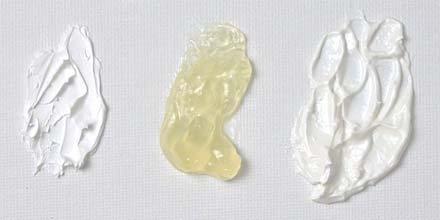
Rublev Colours Lead White Artist Oil (left), Oleogel (middle), and Oleogel mixed with Lead White (right)
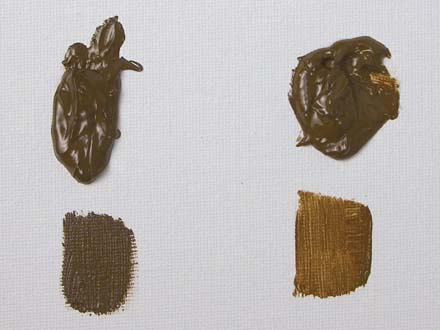
Rublev Colours French Raw Sienna Artist Oil (left), Oleogel (middle), and Oleogel mixed with French Raw Sienna (right).
Oleogel adds transparency to whites without losing the body of the paint. Oleogel is shown in the center, with Lead White on the left and a mixture of Oleogel and Lead White on the right. The Lead White is stiff, plastic, and short, but when mixed with Oleogel, the mixture is semi-transparent, soft, yet sculptural.
What Customers Say About Oleogel
William Whitaker: I’ve found that it’s easier to oil out with Oleogel than anything else I’ve used. There is much less tendency for the oil to bead up. Sometimes I use my fingers to apply it. Sometimes I use a brush. The result is a very thin layer—much like a well-oiled firearm. I don’t use dryers, and I work on several paintings at a time, so I let days go by between sessions on a given painting, which allows the work to set well enough that the paint doesn’t come up when I oil out.
Kenneth Freed: I have been using Oleogel as a wet cushion for some time now and have been very satisfied. Much of the usefulness of a wet cushion (whether it is Oleogel or another medium) depends on what you are trying to achieve. I reserve wet cushions for upper layers when I want to build translucent glaze and scumble layers. Adding Oleogel directly to the paint is an ideal way to control the quantity used in a painting and helps change the viscosity of the paint and the handling characteristics.
Steve Ladd: Oleogel has a nice consistency, more like salve than another gel I tried that coagulated into gooey blobs. I like touching and smearing it around with my finger, and I imagine rubbing will be part of my next painting. Maybe in a “wet cushion,” although I don’t paint in isolated sections of a painting, I am all over the place, so I don’t know if I can use the wet cushion method.
Jive Dadson: I’ve been adding a bit of stand oil to the Oleogel for oiling out and making a couch for glazing. The Oleogel provides the slick, and the stand oil the sticky. Together the Oleogel and stand oil, when added to paint, behave somewhat like Maroger’s Medium. You can push the paint around on the support, but it stays in place. Add a tiny bit of linseed or walnut oil to the mixture, and it will level.
Oleogel increases transparency without flow out and leveling. In the image at right, Rublev Colours French Raw Sienna (left) is shown in a mixture of Oleogel and Raw Sienna on the right. Below each is a brush out of the above examples. Rublev Colours French Raw Sienna is long yet holding strokes well. When Oleogel is added to Raw Sienna, it increases transparency without causing flow out and leveling of brushstrokes, typical when mixing colors with bodied oil or thinners.
How to Use
Mix directly into your paint right on the palette.
To make your paint with Oleogel, add directly to pigment powder until a stiff paste is obtained (almost the consistency of putty). Grind the paste with a muller on a flat surface before storing it in a collapsible tube. Some of its thixotropic properties will be temporarily lost when grinding Oleogel with a muller but should be restored when allowed to stand.
Rublev Colours Walnut Oil Gel is a thixotropic gel medium made with walnut oil for slower drying.
Rublev Colours® Walnut Oil Gel
Shop Now for
Walnut Oil Gel is a thixotropic painting medium made with walnut oil and pyrogenic silica. Walnut Oil Gel is a clear pale amber gel that adds transparency and a thixotropic body to oil, resin-oil, or alkyd paint. Add directly to your paint to give it transparency without thinning its consistency. Add pigments or extenders to thicken it to create impasto effects that do not sink in.
Walnut Oil Gel does not contain driers or solvents, so it is safe to use in oil painting without the worry of cracking. Walnut Oil Gel will increase the drying time when mixed with oil colors.
How to Use
Mix directly into your paint right on the palette.
To make your paint with Walnut Oil Gel, add directly to pigment powder until a stiff paste is obtained (almost the consistency of putty). Grind the paste with a muller on a flat surface before storing it in a collapsible tube. Some of its thixotropic properties will be temporarily lost when grinding Walnut Oil Gel with a muller but should be restored when allowed to stand.
Walnut Oil Gel is available in 50 ml and 150 ml collapsible tubes and eight fluid-ounce (236.6 ml) cans.
Ruble Colors Epoxide Oil Gel is a copolymerized linseed oil gel medium for faster drying, flow out, and leveling.
Rublev Colours® Epoxide Oil Gel
Shop Now for
Epoxide Oil Gel is a thixotropic painting medium made with dicyclopentadiene copolymer linseed oil and pyrogenic silica. Epoxide Oil Gel is a translucent yellow gel that adds transparency and a thixotropic body to oil, resin-oil, or alkyd paint. Add directly to your paint to give it transparency without thinning its consistency. Add pigments or extenders to thicken it to create impasto effects that do not sink in.
Epoxide Oil Gel does not contain driers or solvents, so it is safe to use in oil painting without the worry of cracking. Epoxide Oil Gel will decrease the drying time when mixed with oil colors. Epoxide Oil Gel is tacky, so we do not recommend adding more than 20 to 30% to your paint.
How to Use
Mix directly into your paint right on the palette.
To make your paint with Epoxide Oil Gel, add directly to pigment powder until a stiff paste is obtained (almost the consistency of putty). Grind the paste with a muller on a flat surface before storing it in a collapsible tube. Some of its thixotropic properties will be temporarily lost when grinding Epoxide Oil Gel with a muller but should be restored when allowed to stand.
Epoxide Oil Gel is available in 50 ml and 150 ml collapsible tubes and eight fluid-ounce (236.6 ml) cans.
Rublev Colours Oleoresogel is a thixotropic alkyd gel medium
Rublev Colours® Oleoresgel
Shop Now for
Oleoresgel is a thixotropic gel painting medium made with bodied linseed oil, alkyd resin, odorless mineral spirits, and pyrogenic silica. Oleoresgel is a clear pale amber gel that adds transparency and a thixotropic body to oil, resin-oil, or alkyd paint. Add directly to your paint to give it transparency without thinning its consistency. Add pigments or extenders to thicken it to create impasto effects that do not sink in.
Oleoresgel does not contain driers, so it is safe to use in oil painting without the worry of cracking. You may find that Oleoresgel slows the drying time when mixed with paint. However, most artists using Oleoresgel find that it does not extend the drying time of oil colors.
Oleoresgel is available in 50 ml and 150 ml collapsible tubes.
How to Use
Mix directly into your paint right on the palette.
To make your paint with Oleoresgel, add directly to pigment powder until a stiff paste is obtained (almost the consistency of putty). Grind the paste with a muller on a flat surface before storing it in a collapsible tube. Some of its thixotropic properties will be temporarily lost when grinding Oleoresgel with a muller but should be restored when allowed to stand.
Rublev Colours Wilson’s Medium is a fast-drying gel of pale-bodied linseed oil based on the Medium used by the eighteenth-century landscape painter Richard Wilson.
Rublev Colours® Wilson’s Medium
Shop Now for
Wilson’s Medium is a transparent, gel-like oil medium based on the eighteenth-century oil painting medium of thickened linseed oil, turpentine, and beeswax used by the English landscape painter Richard Wilson (1 August 1714–15 May 1782), who may reasonably claim the honor of being ‘the father of British landscape painting,’ and, according to George Field, also used by Joshua Reynolds. We’ve taken the original formula and improved upon it by using the palest-bodied linseed oil, pure distilled gum spirits of turpentine, and rheological castor wax instead of beeswax.
Castor wax is obtained by the controlled hydrogenation of natural castor oil. When molten, it is clear, transparent, and essentially colorless. Castor wax is practically odorless and has the same toxicity as linseed or other vegetable oils. Castor wax is harder than most other waxes, so it can be used in much smaller amounts than beeswax to provide the same properties.
Wilson’s Medium is available in 50 ml and 150 ml collapsible tubes and eight fluid-ounce (236.6 ml) cans.
Suggested Uses
Mix Directly with Oil Paints. No driers or resins are added to Wilson’s Medium so that it can be safely added to oil paints. Mix it directly with colors to give oil paint a buttery consistency that holds brushstrokes yet dries to a satin finish.
Use to Make Oil Paint. Add Wilson’s Medium to pigment and oil when making your paint. Paints often need the addition of rheological additives to prevent the settling of pigments during long storage periods and to impart specific behavioral characteristics, such as preventing slumping. Wilson’s Medium changes the viscosity of paint by thickening it and imparts rheological properties, such as shear thinning (thixotropy).
Use to ‘Oil Out’ or as a Painting Couch. Wipe a thin coat of Wilson’s Medium onto the surface of the dried paint just before painting a fresh layer. Wilson’s Medium restores the paint’s dried, matte appearance to a fresh appearance without making it glossy.
How to Use
Spread thinly onto the surface and paint directly into it or mix directly into the paint on the palette to give colors a flowing consistency that holds brush strokes yet dries to a satin finish. Use to “oil out” or as a painting couch by rubbing a thin layer onto completely dried paint. Gives the paint a more extended, flowing consistency.
Recommendation: Keep the lid tightly closed to prevent Wilson’s Medium from skinning in the can while in storage.
WARNING! CONTAINS TURPENTINE. Please do not take it internally. Avoid eye and skin contact. Avoid prolonged exposure by inhalation. Use with adequate ventilation. KEEP OUT OF REACH OF CHILDREN AND PETS. Conforms to ASTM D 4236 health requirements.
Rublev Colours Italian Varnish is a black oil gel medium based on Mérimée’s eighteenth-century recipe, also known as Italian Medium.
Rublev Colours® Italian Varnish
Shop Now for
Jean-François-Léonor Mérimée first mentioned Italian Varnish in his 1839 book, The Art of Painting in Oil and Fresco, as a “strong oil prepared in Italy from a very remote period, and which possesses the double-advantage of drying well, and preventing the flowing about of the most liquid glazing.” Italian Varnish is made using linseed oil, litharge, wax, and a small amount of gum turpentine, ground as fine as possible. We have made it with some improvements to the method and materials given in the recipe by Mérimée. It is an amber gel medium that performs similarly to Maroger medium. Instead of mastic, this Medium incorporates wax, which is ideal for those artists who prefer a thicker painting consistency and faster drying time.
Italian Varnish sets quickly while providing transparency and body to oil colors when mixed with them in glazes. It gives a soft consistency to paint, making it possible to use in many different and subtle techniques. In addition to the soft sheen of the Medium, the artist now also has the means of more rapid execution. Artists can mix the Italian Varnish into light pigments (Lead White, Lead-Tin Yellow, Naples Yellow, Yellow Ocher, etc.) to give these colors more body and a thicker consistency. It can help to build up the lights and adds transparency and impasto for the brightest passages of a painting.
Italian Varnish is available in 50 ml and 150 ml collapsible tubes.
How to Use
Mix Directly with Oil Paints. Mix it directly with colors to give oil paint a buttery consistency that holds brushstrokes yet dries quickly to a satin finish.
WARNING! CONTAINS LEAD AND TURPENTINE. Please do not take it internally. Avoid eye and skin contact. Avoid prolonged exposure by inhalation. Use with adequate ventilation. KEEP OUT OF REACH OF CHILDREN AND PETS. Conforms to ASTM D 4236 health requirements.
Rublev Colours Venetian Medium is a black-oil medium based on how sixteenth-century Venetians used powdered glass in their paintings.
Rublev Colours® Venetian Medium
Shop Now for
Venetian Medium is an oil-painting medium based on the research that sixteenth-century Venetian painters added powdered glass to their paint. Venetian Medium contains leaded crystal glass powder, the palest-bodied linseed oil, and turpentine with small amounts of wax and lead drier. Spread thinly onto the surface and paint directly into it as a couch or add directly to the paint nut. Smooths the edges of the brush or knife strokes. Venetian Medium is fast setting and dries to a satin finish.
Venetian Medium is available in 50 ml and 150 ml collapsible tubes.
How to Use
Spread thinly onto the surface and paint directly into it or mix directly into the paint on the palette to give colors a flowing consistency that holds brush strokes yet dries to a satin finish. Use to “oil out” or as a painting couch by rubbing a thin layer onto completely dried paint. Gives the paint a more extended, flowing consistency.
Recommendation: To prevent Venetian Medium from skinning in the can while in storage, add a small amount of linseed oil to cover the Medium’s surface.
WARNING! CONTAINS LEAD AND MINERAL SPIRITS. Please do not take it internally. Avoid eye and skin contact. Avoid prolonged exposure by inhalation. Use with adequate ventilation. KEEP OUT OF REACH OF CHILDREN AND PETS. Conforms to ASTM D 4236 health requirements.
Gel Medium Questions and Answers
What is a thixotropic gel?
Thixotropy is the property of some fluids to change viscosity as they are agitated. The longer the fluid is agitated, the lower its viscosity. A gel is mostly liquid in composition but behaves more like a solid. When a thixotropic gel is agitated, such as manipulated with a palette knife or brush, it begins to flow, but when the agitation is stopped, it regains its former viscosity and stiffens.
What are the working properties of Oleogel and Oleoresgel?
Both gel mediums increase the transparency of oil colors without making the paint more fluid, such as when adding drying oil to increase the transparency of a color. This is advantageous when you want a transparent layer of color without making the paint runny. The pyrogenic silica in these mediums adds a little drag while brushing, and its transparency creates wonderful possibilities for layered painting techniques.
Can I use Oleogel or Oleoresgel to make opaque impastos?
Both Oleogel and Oleoresgel increase the transparency of colors. Oleogel and Oleoresgel are soft gels, so as you add more to your paint, the softer and more transparent it will become. For heavier impastos or textures, we recommend adding calcite (calcium carbonate) to Oleogel or Oleoresgel in combination with your oil colors. A more convenient method of building thick, opaque impastos is using Rublev Colours paste mediums, such as Impasto medium or Velazquez Medium, instead of gel mediums.
I use a wax medium with my oil paint. Can Rublev Colours Oleogel or Oleoresgel be mixed with this Medium?
Both gel mediums are compatible with wax pastes and resinous mediums. We do not recommend heating Oleogel or Oleoresgel to mix it with wax, but rather adding the wax as a soft paste directly to the Medium or melting the wax in linseed oil before adding it to Oleogel or Oleoresgel.
Can I add driers to Oleogel or Oleoresgel to hasten drying?
Oleogel and Oleoresgel do not contain driers, so you can add driers to them to speed up their drying time. You will most likely find that driers are not needed. However, if you find driers necessary, add them as you typically use with oil paint. We recommend adding one or two drops of zirconium or lead drier for each tablespoon (5 ml) of medium or the combination of medium and oil colors.
Can Oleogel be mixed with turpentine to make a more liquid medium, or would that negate its inherent properties?
It can be blended with turpentine without detriment to its overall properties, except that you no longer have a gel.
Can I use Oleogel in “wet cushions”?
For best results, Oleogel should be applied whisper thin. You must take your hand and scrape it into a very thin application. Also, do not apply it as a wet cushion onto areas you will not work over. You don’t want layers and layers of Oleogel without paint being worked into it.
Fluid Mediums
Rublev Colours Balsam Essential Oil Medium consists of Canada balsam, spike oil, and pale-bodied linseed oil.
Rublev Colours® Balsam Essential Oil Medium
Shop Now for
Rublev Colours Balsam Essential Oil Medium comprises Canada balsam, pale-bodied linseed oil, and spike oil. Add to colors for enamel-like effects to achieve glow in glazes and facilitate fusion. (44% resin solution).
Add a small amount of Balsam Essential Oil Medium to your paint to make it brush out more easily, adhere better to previous layers, and dry more quickly. Keep the bottle covered to limit evaporation, although you can dilute it with spike oil. Balsam Essential Oil Medium smells wonderful.
Canada balsam is a sap from fir trees. Although not a true balsam, this volatile resin can improve adhesion from one paint layer to another and impart a silky smooth quality to paint. Canada balsam is more transparent and faster drying than other resins, such as Venice turpentine.
Spike oil (essential oil of certain parts of the lavender plant) is an organic solvent, like spirits of gum turpentine, except that it evaporates more slowly. It has a powerful and agreeable smell. It has a long history in oil painting: Leonardo da Vinci is believed to have used it for the initial dark underpainting in his “sfumato” technique.
How to Use
Mix directly into the paint on the palette to give colors a flowing consistency, yet dries to a satin or gloss finish, depending upon the amount used. Use to “oil out” or as a painting couch by rubbing a thin layer onto completely dried paint. Gives the paint a flowing consistency.
Balsam Essential Oil Medium is available in 4 and 8 fl oz glass bottles.
Rublev Colours Oil Mediums are a series of drying oil mediums thinned with solvent
Rublev Colours® Oil Medium
Shop Now for
Rublev Colours Oil Mediums are a series of drying oil (linseed or walnut) mediums purified and then thickened by exposure to sunlight and air until they are thick and light-colored. They are then thinned with spike oil, distilled spirits of gum turpentine, or odorless mineral spirits (OMS).
As the oils dry naturally, containing no driers or resins, they may be used confidently for their future behavior and longevity. The mediums prepared with spike oil dry the slowest; the medium with odorless mineral spirits dries rapidly, while that prepared with turpentine dries the fastest. Use as a painting medium for "oiling out" to keep oil colors fresh and as a safe drying oil mixed with oil colors on the palette.
Select a medium from one of these options:
No. 1 Linseed oil and spike oil
No. 2 Linseed and turpentine
No. 3 Linseed oil and odorless mineral spirits (OMS)
No. 4 Walnut oil and spike oil
No. 5 Walnut oil and turpentine
No. 6 Walnut oil and odorless mineral spirits (OMS)
Rublev Colours Oil Mediums are available in 8 fl oz glass bottles.
Frequently Asked Questions
What are the main components of oil painting mediums?
Oil painting mediums typically contain drying oils (like linseed, safflower, poppy seed, or walnut oil), resins (such as damar or alkyd resin), and often solvents and driers. These components are crucial in altering the properties of the paint, such as drying time, consistency, and sheen.
What is the role of oil in oil painting mediums?
Oils in painting mediums function as binders and increase transparency, flow, and gloss while slowing drying time and leveling brush strokes. Different oils offer varying attributes regarding drying rate, yellowing, and paint film characteristics.
What are some less common oils used in painting, and what are their properties?
Less commonly used oils include hemp seed, rape seed, perilla, soybean, and tung oil, each having specific properties such as a tendency to yellow or providing a less permeable paint film.
How do different oils like linseed, poppy seed, and walnut oil compare?
Linseed oil is preferred for its durability but can yellow over time, while poppy seed oil is ideal for lighter colors due to its slow drying rate and less prone to discoloration. Walnut oil offers a balance with less yellowing and a durable paint film.
What are alkyd resins, and how are they used in oil painting mediums?
Alkyd resins are synthetic resins used in oil painting mediums to speed up drying times and add gloss and transparency. They have certain limitations compared to natural oils, such as a reduced ability to bind pigments and potential brittleness over time.
What is the difference between various solvents like turpentine, mineral spirits, and oil of spike lavender?
Turpentine is a traditional, strong-smelling solvent, while mineral spirits and, to a greater degree, odorless mineral spirits are less toxic and evaporate more slowly. Oil of spike lavender is a slower-evaporating solvent than turpentine and has a more pleasant aroma, though it is more expensive.
Reference
[1] Navarrete Prieto, Benito., Bezur, Aniko., McClure, Ian., Albendea, Carmen., Stenger, Jens., Marciari, John. The Young Velázquez: The Education of the Virgin Restored. United Kingdom: Yale University Art Gallery, 2014.39.


